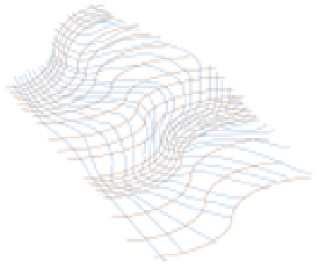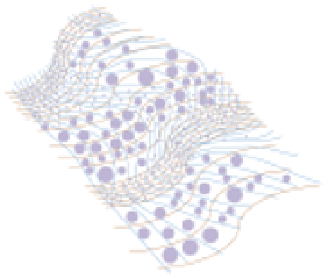Environmental Engineering Reference
In-Depth Information
The hexa-dpi structure:
- As traditional cell structures the hexa-dpi-structure base is a matrix, in this case an
irregular matrix (the hexagon is the basic unit of every hexa-matrix) - therefore no
uniform spatial unit (SU)
- Each hexa-cell accommodates a dot - the grouping of dots in patterns will define an object
- Dots will ensure 3D structure
- The interplay of dots-per-inch and hexa-matrix will define a scale and units of analysis
- Zooming-in/out will immediately redefine the scale of analysis and the units
- Objects resulting from dot-pattern identification will have different mobility rates (i.e
microseconds-seconds-minutes-days-years-centuries-millennia), this will be indexed to
scale and units of analysis
6.1.
6.2.
Classifiers of objects
embed attributes into
hexa-dpi
6.3.
The Cellular Environment
-Dot size and hexa-matrix will define the unit of analysis and scale
-Scalability will be a proportion of the object (i.e. 2 times current scale or phenomena's
fractal dimension)
-Scale will be variable in for each T-time accordingly to object zoomed in
-Image recognition of dots/patterns will form objects (that can feed attribute tables)
-The matrix will grant horizontal integrity of the same perspective
-A zoom-in will immediately re-scale dots-patterns to new perspective and new objects
or more detail will be unveiled and allow scalability
-The hexa-matrix will also allow vertical integrity as it will allow to 'filter' to lower levels fine-
grained dots allowing to build the next zoom-in level (and the next scale and unit of analysis)
-Obviously scalability to upper levels isn't a problem as there are many algorithms that
already to that.
Having the Cellular Environment defined in such a way makes it easy to incorporate
the agent's
behavioural/environment
-Agents will be the 'materialization' of some of the 'mobile'-physical structures into mobile
objects (i.e. aggregation of so me of the dots) across the matrix for different time spans,
or for the same time/space when zooming in. This materialization for a sequence of
time-frames for objects will depend on the observable hexa-dpi structure.
In theory, this new data-structure and new-cartographic representation will allow to chart
from planetary/galaxy to the particle and sub-particle levels (and, in between, the surface
of the earth), for both mobile/immobile objects in a specific Time. Because everything is
mobile across time (depending of the scale of analysis), but immobile in each time-frame
this seems to be the best compromise to answer to the needs to these two different data
structures.
FIGURE 22.6
The hexa-dpi structure, and the cellular agents environments.














Search WWH ::

Custom Search